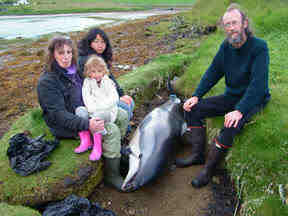White sided dolphins strand yet again in Weisdale
Voe July 2007

 On Friday 20
July 2007 we were called by local SSPCA inspector Ron Patterson who told
us that one of the two Atlantic white-sided dolphins which had been
swimming all week in Weisdale Voe, on Shetland’s west side, had
stranded.
The call came in at 8am, but with two young seal pups to look after and
a houseful of volunteers to organise, it was late morning by the time
Jan, Pete, Maya (Jan’s grand daughter) and Mariko, from Japan, set off
in our LandRover for the 30 mile journey from Hillswick to Weisdale.By
the time we reached the voe the female dolphin had been put down
"humanely". A local crofter, under the guidance of Ron, had shot her.
They had tried several times to push her back into the water, but she
kept coming straight back to strand. The male that was with her also
tried to strand itself, but they managed to keep him in the sea.The dead
dolphin’s body was hauled across the voe and we helped to bring her up
to the road and load her on to the pick up which had been brought to the
scene by Scottish Natural Heritage, who are sending her off to the SAC
Veterinary & Advisory Service for a post mortem.Meanwhile Jonathan Swale
and another SNH employee were herding the male dolphin back out of the
voe. He was clearly reluctant to leave, and as soon as SNH left he swam
straight back in to the shallows.The four of us stayed all afternoon,
watching the dolphin swim in ever decreasing circles. It was becoming
weaker and weaker, finding it harder and harder to keep upright, its
breathing becoming shorter and more stressful all the time.Weisdale Voe
is beside a busy road and there was a constant stream of vehicles
driving past, many stopping to have a look at the distressed creature.
When no one was there it looked as if the dolphin would beach, but as
soon as a crowd turned up it went back into the middle of the voe.
At around 6pm we decided to head off to Lerwick to get some food. Jan
however decided to stay to keep an eye on the dolphin. She had a feeling
that it was nearing the end.
While Pete, Maya and Mariko were getting food, the dolphin got stuck on
a sand bank as the tide was going out. It started to thrash violently.
Blood started to spurt from its rear end. A crowd gathered to watch in
horror as it went through its death throes. It took about 20 minutes
before it finally died.
It was a terrible death to witness, but at least it was a natural death.
Many people might think it is best to "put a creature out of its
misery", but that can often be because we do not wish to witness the
pain of a creature suffering.
Wild animals know how to die. This male dolphin wanted to beach when
its mate first stranded. Had it happened during the night when no people
were around, both creatures would probably have died together. Who
knows, by trying to herd the male out of the voe we may only have been
prolonging the inevitable and perhaps extending its suffering. It’s very
difficult to know when you are actually helping a wild creature and when
you are interfering and making matters worse. But with each experience
we learn more, though the final decision is always left with the SSPCA.
Three years ago, in August 2004, five dolphins stranded in the same
spot. Two were dead when we arrived first thing in the morning. A group
of volunteers spent the rest of the day trying to encourage the others
back to the open sea, but only one of them carried on swimming. Two
became progressively weaker until a decision was taken to put them out
of their agony.
We believe the fifth dolphin was a pregnant mother. Shortly after this
stranding a mother and her calf stranded in the same voe. We believe
this could have been the fifth dolphin and her baby, though we will
never know for certain.
One thing is for sure, the bond between these creatures is incredibly
strong and once one of a family has decided to die, the others often
appear to lose their will to live.
There is much that we do not understand about these beautiful
animals…not least why they keep returning to the same place. In 2005 two
white-sided dolphins stranded in Weisdale Voe but two men on their way
to work stopped and managed to save them and put them back out to sea.
Since then there have been several dolphin sightings in this voe, but no
strandings until now.
For us, whatever the outcome we always feel it an honour to have the
opportunity to have such close contact with these creatures, though
obviously we would much prefer to see them head safely back out to sea. |
Almost every year it seems we are called out to strandings of either
whales or dolphins around the coast of Shetland.
On the weekend of 9 & 10 June this year (2007) we had a particularly
distressing experience, which illustrated the huge dangers posed to
marine life by litter, especially plastic, discarded in the sea.
A call came in about a whale or dolphin in distress in Scalloway
harbour, a busy port on Shetland’s west coast. Jan went to
investigate along with others from the local Shetland Marine Mammal
Group and Ron Patterson from the SSPCA.
They discovered the creature was a juvenile minke
whale about five metres long. No one had seen a whale look so
emaciated. Several people took photos, and when they examined the
shots they realised the whale had a deep gash in its neck from a
piece of plastic. The trouble was that with it still being at sea,
no one could do anything to help it. Jan thought it had probably
come in to die.
That evening Ron stayed until 10pm keeping watch. He
went out early on Sunday morning and it had disappeared. Fishermen
working in the harbour said they hadn’t seen it that day.
During the day another call came in about a pod of
dolphins circling in Weisdale Voe, where a pod of white-sided
dolphins had stranded three years ago. Jan, Pete, Bunchy and Paddy
all went out to see what was going on, but the dolphins were just
feeding and left the voe, much to our relief.
We returned to Hillswick only to get another call from Scalloway. A
man had found the minke whale’s body washed up beside a huge pile of
rubbish on the beach by the East Voe marina. We raced down to see it
and met Ron when we got there.
We found the poor whale had a thin piece of black
strapping wrapped around its neck, which had eaten into its flesh as
it grew, eventually killing it. A horrible way to die.
It was incredible where it stranded. It was
underneath an old salmon cage, surrounded by piles of rubbish. It
seems like the whale was trying to tell us something about the way
we look after the sea!
|


